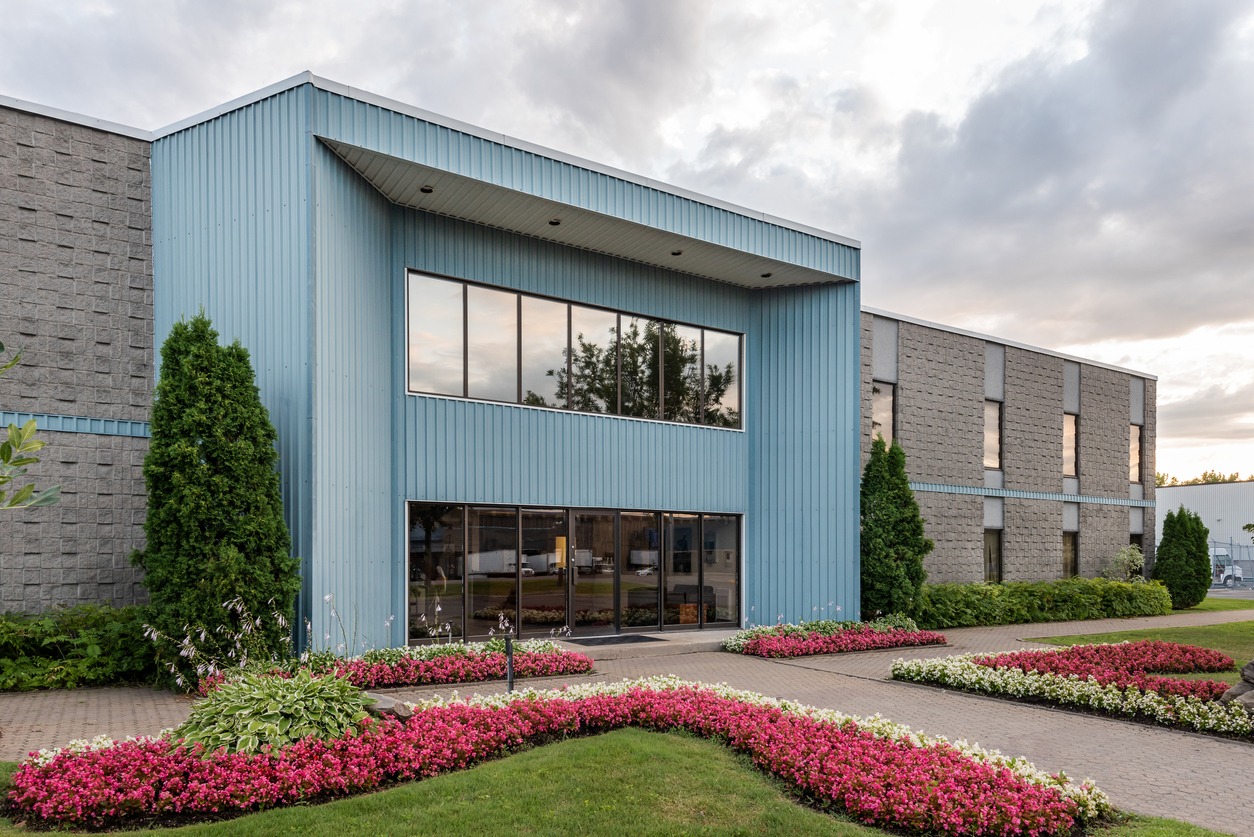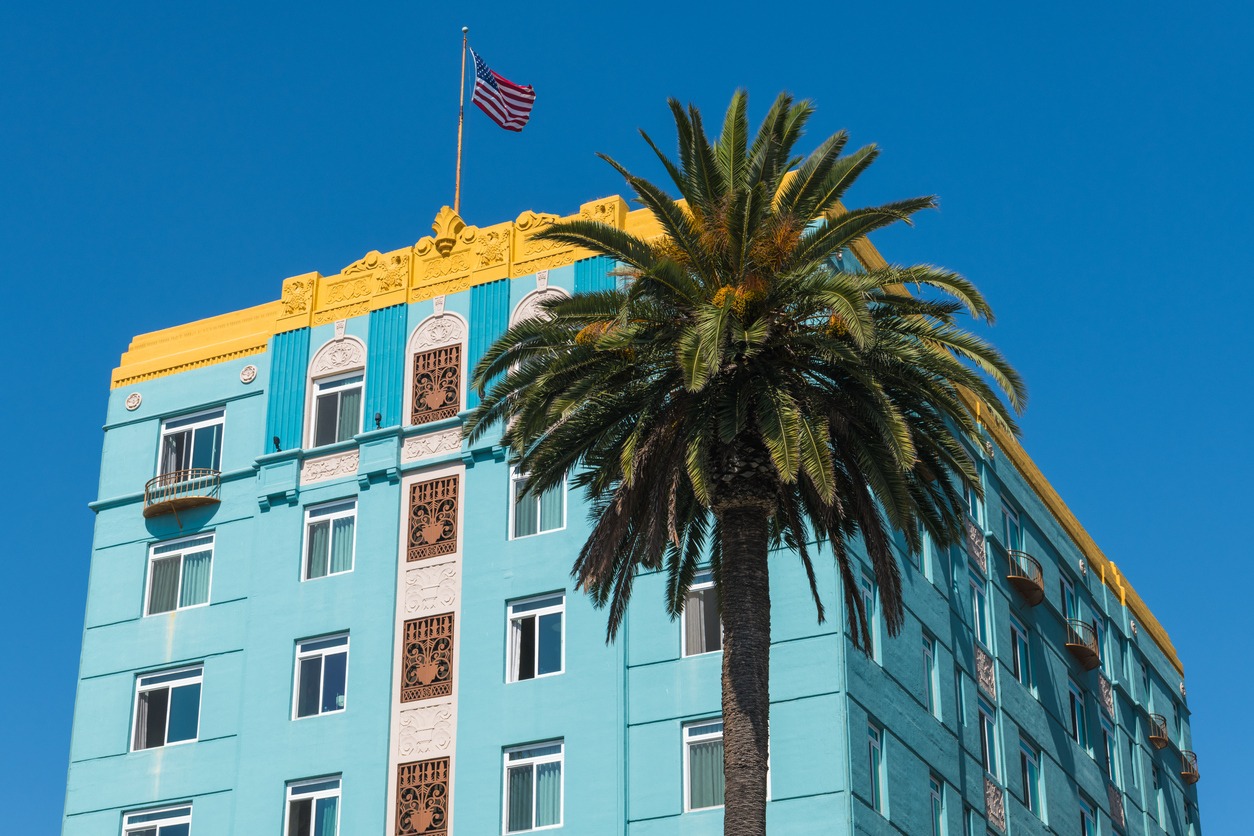Painting a commercial building should be a crucial part of a business’s strategy to maintain its appeal and profitability. Maintaining the complex’s exterior and interior appearance helps make a positive first impression, ensure safety, and protect property value.
A fresh coat of paint significantly enhances aesthetic appeal, bolsters durability against the elements, and can even increase property value by improving overall appearance. Before starting a painting project, businesses should consider factors like paint quality, color choice, surface preparation, and timing to ensure a successful and lasting result.
Signs it’s time to paint your building

Any business owner should know that repainting a commercial building is a demanding project. It can disrupt a business’ usual operations and tenants’ daily routines. How you handle these disruptions accompanying this project can have a long-term impact on your business’s stability.
Commercial painting also doesn’t come cheap. Without careful planning, the project can end up costlier than expected. To prevent that scenario, you should know the dimensions and challenges accompanying commercial painting.
But first, why should your commercial building’s walls be fresh and new? Here are the following signs that it’s time to repaint.
- Visible damage: Look for peeling, cracking, or fading paint. These signs indicate that the paint is weathered and no longer provides adequate protection or aesthetic appeal.
- Brand refresh: If you’re updating your brand or logo, consider changing the building’s color to reflect your new identity. It can help align your physical space with your updated brand image.
- Regulatory requirements: Check local laws or tenant agreements, as they may mandate regular upkeep or specific maintenance standards, including repainting at set intervals.
- Outdated look: If the building looks dated or worn, a fresh coat of paint can modernize its appearance, making it more attractive to potential customers or tenants.
Choosing the right time for painting
When is the right time for commercial painting? Consider these factors below:
Seasonal considerations
Weather significantly affects painting projects. Optimal times for exterior painting are typically spring and summer due to warmer temperatures and lower humidity, which ensure better paint adhesion and drying. Avoid painting in extreme temperatures or high humidity, as it can affect the paint’s finish and longevity.
Minimizing business disruption
Schedule painting during off-peak hours, weekends, or during slower business seasons to minimize disruption. It allows you to maintain regular operations while the project progresses. For indoor painting, consider night shifts or off-hours to avoid interfering with day-to-day activities.
Building occupancy
If you keep the building open, coordinate with tenants and customers to ensure you meet their needs. Inform them of the painting schedule in advance and consider using barriers and signage to manage access and minimize disruption. For businesses with high foot traffic, plan the project in phases to keep areas open and functional.
Selecting the right paint
Selecting the right paint for a commercial building involves:
- Durability and weather resistance: Choose paints designed for your specific climate, like UV-resistant for sunny areas or water-resistant for humid regions, to ensure longevity and protection.
- Environmental impact: Choose low-VOC or eco-friendly paints to support green building practices and enhance indoor air quality.
- Brand alignment: Select colors that align with your company’s branding to reinforce its professional image and appeal.
- Finishes and textures: Consider the finish based on application. Matte hides imperfections but may require more maintenance, satin offers a balance of durability and sheen, and glossy provides a high shine but can show wear more easily.
Surface preparation and repairs
Even if you have the best-quality paints, they will end up poorly on your walls if they have surface issues like dirt, stains, mold, cracks, and holes. These surface issues will make your commercial building less appealing to your prospective and long-time clients. Here are the things you need to know about surface preparation and repairs before painting:
Assessing the building’s condition
Before painting, inspect the building for cracks, mold, or structural damage. This ensures that any underlying issues are addressed, as these problems can affect the paint’s adhesion and longevity. Cracks and structural damage need repair to prevent further deterioration, while mold must be removed to avoid health risks and paint failure.
Cleaning and priming
Proper cleaning removes dirt, dust, and grease. These contaminants prevent the paint from adhering correctly and lead to an uneven finish. Priming helps seal the surface, covering stains and ensuring better paint adhesion. It also provides a uniform surface, which is essential for achieving a smooth, long-lasting finish.
Repairs before painting
Addressing repairs is crucial to ensure a durable and aesthetically pleasing result. It includes fixing holes with patching compound, pressure washing to remove grime and loose paint, and sealing leaks to prevent water damage. Taking these steps helps avoid issues like peeling, bubbling, or uneven paint coverage in the future.
Compliance with local building codes
Following these local building codes and guidelines helps ensure that commercial painting projects are aesthetically pleasing, safe, and compliant with local regulations.
Color restrictions
In some areas, particularly historic districts, there may be regulations on color choices to maintain aesthetic consistency and preserve architectural heritage. Always check with local zoning or planning departments to ensure your color scheme aligns with these requirements.
Safety regulations
Adhering to safety protocols is crucial, particularly in high-traffic or occupied areas. These include proper ventilation, protective gear for workers, and marking the work area to prevent accidents. Compliance with OSHA (Occupational Safety and Health Administration) standards is also essential.
Fire-resistant and protective coatings
Certain buildings, such as industrial facilities or hospitals, may require fire-resistant coatings or other specialized treatments to meet fire safety codes or industry-specific standards. To enhance safety and compliance, ensure that the coatings used are certified and appropriate for the intended use.
Hiring a professional commercial painter
From time savings to safety to superior-quality results, here’s why partnering with a professional commercial painter can make a big difference to business:
- Experience and expertise: Professional commercial painters bring specialized knowledge in handling large-scale projects and complex environments. Their expertise ensures high-quality finishes and adherence to industry standards, which is crucial for maintaining commercial spaces’ aesthetic and functional integrity.
- Project management: Commercial painters manage all aspects of the job, including scheduling, material sourcing, and team coordination. Their expertise in project management helps ensure that the work is completed on time and within budget, minimizing disruptions to your business operations.
- Warranties and guarantees: Choosing a commercial painter who offers warranties on workmanship and materials provides peace of mind. It ensures that any issues that arise after the job is completed will be addressed, protecting your investment and enhancing the longevity of the work.
- Safety measures: Insured and licensed commercial painters adhere to safety regulations and standards, reducing the risk of accidents and property damage. It safeguards your property and minimizes liability, making it a crucial consideration when hiring professionals.
Cost and budget considerations
In any project, budget plays a significant factor. To keep your budget from spiraling out of control, you must plan it carefully for your commercial painting. Here are some key cost and budget considerations:
1. Initial estimates vs. long-term value:
- Initial estimates: Higher-quality paint and professional application are typically costly. However, investing in these can result in better durability and a more polished finish.
- Long-term value: Opting for high-quality materials and skilled labor can reduce the frequency of touch-ups and repainting, ultimately saving money on maintenance and downtime.
2. Hidden costs:
- Repairs: Surface preparation might uncover underlying issues that require repair before painting, adding unexpected costs.
- Permits: Depending on the location and scope of the project, permits might be required, which can add to the budget.
- Specialty paints: If your project requires specialty paints (e.g., anti-mold, fire-resistant), these can be more expensive than standard options.
3. Financing and payment plans:
- Options: For larger commercial projects, financing options might include business loans, lines of credit, or leasing agreements.
- Payment plans: Some contractors offer payment plans that allow you to spread the cost over time, which can ease cash flow pressures.
Balancing these factors ensures that you’re prepared for both the immediate costs and the long-term financial impacts.
Conclusion
Careful planning and professional execution ensure a high-quality, durable finish that enhances your commercial building’s appearance and protects it from damage. Proper planning helps select the correct materials and colors, schedule work to minimize disruption and address any structural issues. Professional execution guarantees adherence to safety standards, effective use of resources, and a flawless result that reflects positively on the business.
Regular repainting preserves your commercial building’s appearance and structural integrity, protecting it from damage and wear. This proactive maintenance boosts curb appeal, extends the lifespan of surfaces, and can ultimately save on costly repairs.
If you’re a property owner or manager in and around the Bay Area, consult Custom Painting, Inc. to ensure a smooth process and high-quality results. Call us at 925-294-8062 or message us here to get a free quote! Our expertise guarantees proper planning, efficient execution, and a professional finish that enhances your commercial building’s appearance and longevity.




